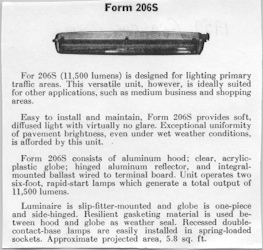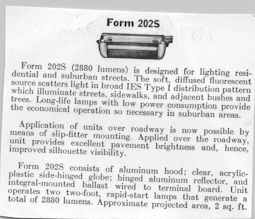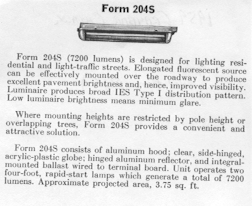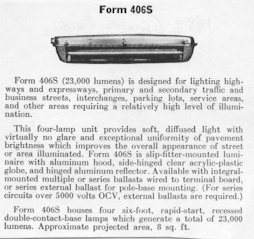
GE Form 406-S luminarie mfd. 1958
Although not commonly used for streetlighting today, fluorescent lighting was an option from the late 1950s into the 1970s. General Electric introduced these luminaries in the mid-to late 1950s and was the leading manufacturer of fluorescent streetlights with several sizes available by 1959. Their smallest one - the Form 202-S - was a two lamp fixture that accommodated two-foot long lamps providing a total light output of 2,880 lumens. Larger fluorescent streetlighting luminaries were their: Form 204-S that provided 7,200 lumens, utilizing two four-foot, rapid start (RS) lamps; Form 206-S, rated at 11,500 lumens, employing two six-foot RS lamps; and their Form 406-S, at 23,000 lumens, General Electric's largest, containing four six- foot RS lamps.
The latter was built with an integral multiple operation ballast, but was optionally available with either a series operation isolation transformer or without any internal auxiliary equipment for metal pole base installation of a series transformer. The 406-S is probably the largest streetlighting luminarie ever built (see photo within this section). All fluorescent lamps used for streetlighting in the above fixtures produced cool white light and had recessed double contact bases.
A significant increase in light output was made possible by using General Electric's "Power Groove" fluorescent lamps within their fixtures. Utilizing them in their small Form 204-S provided 12,000 lumens (a 67% increase); the 206-S with these lamps provided a 62% increase (18,600 lumens) and installing them in their big Form 406-S resulted in the same percentage increase in light output, resulting in an impressive 37,200 lumens. Power Groove lamps were similar to standard straight tubular fluorescents except they were designed so that the tube had equally spaced indentations on one side with a corresponding ridge on the other side. Power Groove lamps became very popular, especially for exterior lighting applications.
The advantages of fluorescent streetlighting were high luminous efficiency, long lamp life and excellent color rendition. Fluorescent streetlighting fixtures were a somewhat common sight throughout the 1960s, particularly in the East and Midwest.
The earliest fluorescent streetlighting luminaries manufactured by General Electric were finished in natural aluminum on their upper exterior with a hinged clear plastic diffuser or protector that enclosed the lamps. An internal polished aluminum reflector was included inside for desired light distribution. By 1966 General Electric's fluorescent streetlighting fixtures were painted light gray on their upper portion and were slightly less cumbersome than their predecessors. Although there is no catalog reference to the fact, it is probable some of General Electric's multiple operation fluorescent streetlighting luminaries were provided with a photocontrol receptacle as an option. Most of their fluorescents were designed to fit upon two-inch diameter pipe arm brackets. The metal poles that supported the larger luminaries were tubular with extra heavy-duty bracket arms affixed to them supplemented by under-supports. Many of these poles with their beefy bracket arms still stand, with newer luminaries on them.
General Electric and likely the other manufacturers discontinued fluorescent streetlighting luminaries by the early 1970s. Mercury vapor and newly introduced light sources such as high pressure sodium and metal halide were competition since the quality of light, lamp life, and light output efficiency were almost equal. One of the drawbacks of fluorescent lights in general is that they typically do not provide optimum light when operated in cold temperatures (below 32 Fahrenheit). The luminaries utilized for fluorescent streetlighting were big and bulky and were less impressive aesthetically in the public's view than other contemporary light source luminaries which were far more compact.
Many fluorescent streetlighting installations remained in service throughout the 1970s; however by the end of that decade most were replaced by other light sources, particularly high pressure sodium. Contributing to the demise of fluorescent streetlighting luminaries was the fact that replacement parts were becoming difficult to obtain after the fixtures were discontinued. Many communities that converted from fluorescent to smaller, more compact streetlighting luminaries discovered that their newly upgraded light sources not only were more pleasing to the eye during the daytime; their new luminaries also provided much improved light distribution and control.
By the late 1980s fluorescent streetlights were a rare sight and by the early 1990s they were practically extinct. Like many other streetlighting luminaries of yesteryear discussed within this website, the fluorescents became victims of vanishing Americana. The only fixtures that may still be seen in service are most probably privately owned, such as within parking lots, etc.

GE Form 406-S luminarie mfd. 1958

GE Form 206-S luminarie mfd. 1968

1959 Graybar catalog

1959 Graybar catalog

1959 Graybar catalog

1959 Graybar Catalog
(c) 1998 by Joe Maurath, Jr.
Continue to the High-Pressure Sodium Lamps page or return to main page